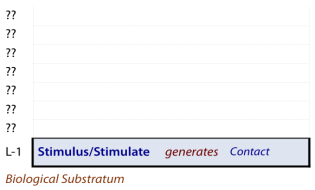Stimuli: The Foundation at L1
Function & Name

The sender actively emits or generates and these are the elemental psychological means in any . To have any communicative effect, the stimulus must generate sufficient impact to . This impact is biologically mediated via a recipient's sensory organs, but for our psychosocial purposes, communication depends on noticing and perceiving.
So this is at Level-1. «» is the THEE-name for «the psychosocial use of biological mechanisms for sending or receiving a message.»
There do not appear to be any alternate names or even close synonyms for ''
are not intrinsically meaningful, but they serve as the essential infrastructure i.e. they are pure means for communication. Read an evolutionary story about this.
To restate: For a to occur:
- the sender (or initiator) must generate that are psychosocially appropriate and recognizable i.e. have the potential to convey meaning or make sense and that are intense enough to create an impact.
- the recipient must notice the i.e. give attention to what is sensed or felt and recognize the potential for meaning.
 Examples of :
Examples of :
From a perspective, fits all requirements:
- created by a person
i.e. fits the initiator/sender criterion; - noticeable by a person
i.e. fits the recipient criterion; - depends on biology
i.e. fits the human criterion; - the simplest deliberate form of
i.e. fits THEE's criterion.
As we will see, are:
- intrinsic to all the more complex, higher-level forms of
i.e. fits the hierarchy criterion.
Errors & Failure
A human must be socially recognizable as a —or it is just another stimulus-sensation, amongst innumerable stimuli that bombard us, continually, as long as we live.
can fail spectacularly at the Level due to:
- inattention—to stimuli-sensations;
- deliberately ignoring the stimulus;
- biological deficiencies e.g. blindness, deafness.
 More.
More.
- are necessary but insufficient for our : proceed to the next level.
Originally posted: 18-Mar-2011; Last updated 25-Sep-2011.